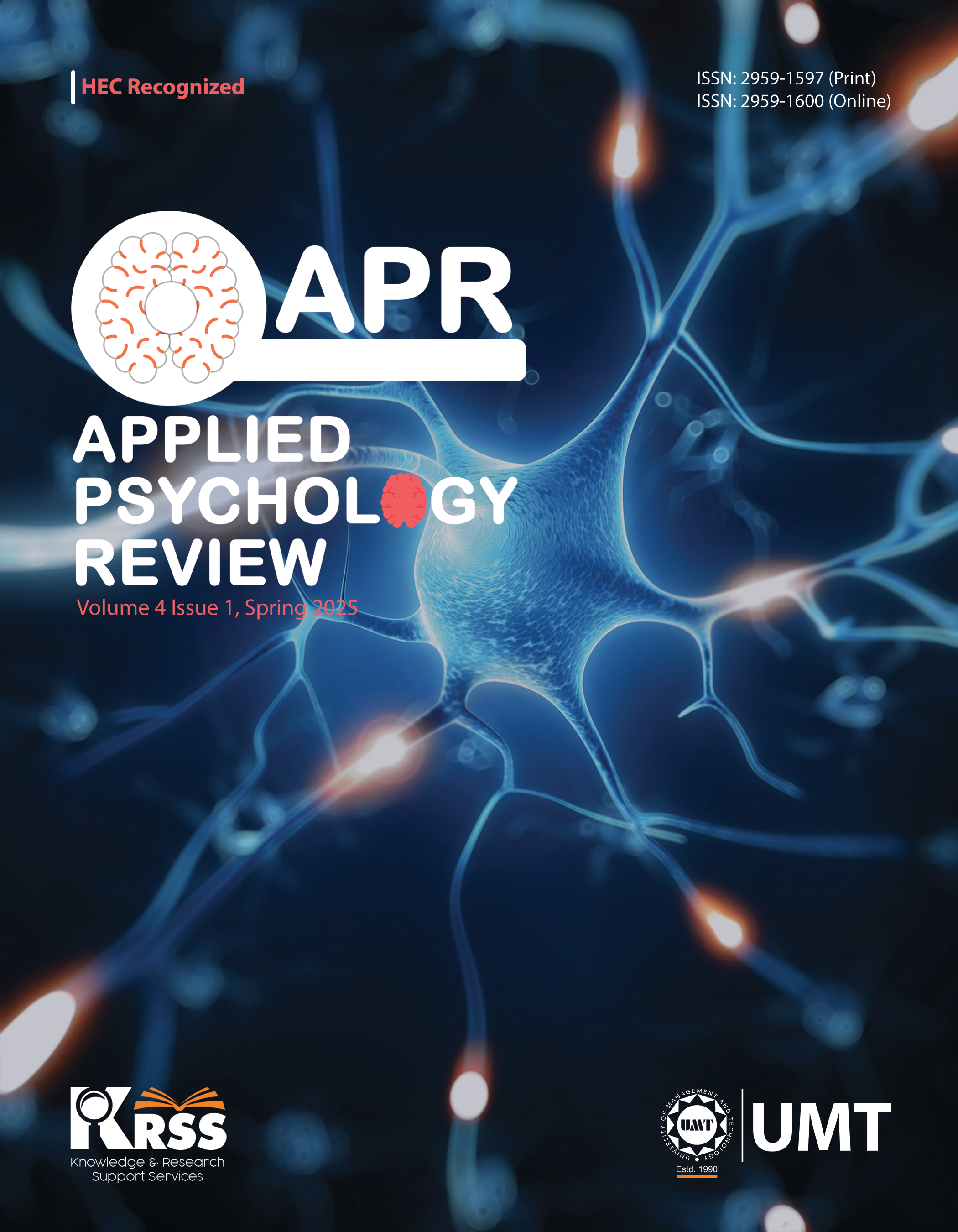Perfectionistic Traits, Competitive Anxiety, and Self-Esteem among Cricket Players
Abstract
 Abstract Views: 0
Abstract Views: 0
The current study aimed to determine the relationship between perfectionistic traits, competitive anxiety, and self-esteem in cricket players. It was hypothesized that; (a) There is likely to be a significant relationship between perfectionistic traits, competitive anxiety, and self-esteem in cricket players; (b) Perfectionistic traits and competitive anxiety are likely to predict self-esteem in cricket players; and (c) There is likely to be gender differences in perfectionistic traits, competitive anxiety, and self-esteem among cricket players. The study employed correlational research design and non-probability purposive sampling for data collection from (N=100) cricket players, both males (n=50) and females (n=50). The Frost Multidimensional Perfectionism Scale, Competitive Sport Anxiety Inventory-2, and Rosenberg Self-esteem Scale measures were used. Results showed a significant positive correlation between perfectionistic traits on the levels of high personal standards, and concern with precision (perfectionistic striving) and self-esteem. Whereas, self-esteem is significantly negatively correlated with concern over mistakes and doubts, and concern with parents (perfectionistic concerns). The results also showed a significant negative correlation between competitive anxiety and self-esteem. Additionally, the results also indicated that high personal standards (subscale of perfectionist traits) positively predict self-esteem, while worry concerns (subscale of competitive anxiety) negatively predict self-esteem. Furthermore, the results indicated significant gender differences between excessive concerns with parents and high personal standards. Females were higher on the level of concerns with parents and high personal standards than males. The current study would be helpful in providing the basis for further empirical research.
Downloads
References
Baumeister, R. F., Campbell, J. D., Krueger, J. I., & Vohs, K. D. (2003). Does high self-esteem cause better performance, interpersonal success, happiness, or healthier lifestyles? Psychological Science in the Public Interest, 4(1), 1–44. https://doi.org/10.1111/1529-1006.01431
Brown, P. (2018). Schooling ordinary kids: Inequality, unemployment and the new vocationalism. Routledge.
Chunying, M., & Ahmad, M. (2023). History of Pakistani cricket team: Challenges and response, 1947-1970. Annals of Human and Social Sciences, 4(4), 542–549. https://doi.org/10.35484/ahss.2023(4-IV)52
Endo, T., Sekiya, H., & Raima, C. (2023). Psychological pressure on athletes during matches and practices. Asian Journal of Sport and Exercise Psychology, 3(3),161–170. https://doi.org/10.1016/j.ajsep.2023.07.002
Flett, G. L., & Hewitt, P. L. (2002). Perfectionism and maladjustment: An overview of theoretical, definitional, and treatment issues. In G. L. Flett & P. L. Hewitt (Eds.), Perfectionism: Theory, research, and treatment (pp. 5–31). American Psychological Association. https://doi.org/10.1037/10458-001
Flett, G. L., & Hewitt, P. L. (2014). A proposed framework for preventing perfectionism and promoting resilience and mental health among vulnerable children and adolescents. Psychology in the Schools, 51(9), 899–912. https://doi.org/10.1002/pits.21792
Frost, R. O., Marten, P., Lahart, C., & Rosenblate, R. (1990). The dimensions of perfectionism. Cognitive Therapy and Research, 14, 449–468. https://doi.org/10.1002/ar.1092260402
Gabrys, K., & Wontorczyk, A. (2023). Sport anxiety, fear of negative evaluation, stress and coping as predictors of athlete's sensitivity to the behavior of supporters. International Journal of Environmental Research and Public Health, 20(12), Article e6084. https://doi.org/10.3390/ijerph20126084 .
Gadde, U., Kim, W. H., Oh, S. T., & Lillehoj, H. S. (2017). Alternatives to antibiotics for maximizing growth performance and feed efficiency in poultry: A review. Animal Health Research Reviews, 18(1), 26–45. https://doi.org/10.1017/S1466252316000207
Ghahramani, H., Besharat, A., & Naghipour, B. (2011). An examination of the relationship between perfectionism and self-esteem in a sample of student athletes. Procedia - Social and Behavioral Sciences, 30, 1265–1271. https://doi.org/10.1016/j.sbspro.2011.10.245
Koivula, N., Hassmen, P., & Fallby, J. (2002). Self-esteem and perfectionism in elite athletes: Effects on competitive anxiety and self-confidence. Personality and Individual Differences, 32(5), 865–875. http://dx.doi.org/10.1016/S0191-8869(01)00092-7
Lorimer, R. (2006). The relationship between self-presentational concerns and competitive anxiety: The influence of gender. International Journal of Sport Psychology, 37(4), 317–329. https://doi.org/10.1016/j.paid.2006.09.006
Marín-González, F., Portela-Pino, I., Fuentes-García, J., & Martínez-Patiño, M. (2022). Relationship between sports and personal variables and the competitive anxiety of Colombian elite athletes of Olympic and Paralympic sports. International Journal of Environmental Research and Public Health, 19(13), Article e7791. https://doi.org/10.3390/ijerph19137791
Martens, R., Burton, D., Vealey, R. S., Bump, L. A., & Smith, D. E. (1990). Development and validation of the Competitive State Anxiety Inventory-2 (CSAI-2). In R. Martens, R. S. Vealey, & D. Burton (Eds.), Competitive anxiety in sport (pp. 117–190). Human Kinetics.
Oudejans, R. R., & Pijpers, J. R. (2009). Training with anxiety has a positive effect on expert perceptual–motor performance under pressure. Quarterly Journal of Experimental Psychology, 62(8), 1631–1647. https://doi.org/10.1080/17470210802557702
Rosenberg, M. (1965). Rosenberg self-esteem scale (RSES). APA PsycTests. https://doi.org/10.1037/t01038-000
Roy, J., Godin, R., Gaudreault, P., & Forest, G. (2023). The relationship between sleep, perfectionistic strivings, perfectionistic concerns, and academic and sports performance in young athletes. Chronobiology International, 4(11),1500–1514. https://doi.org/10.1080/07420528.2023.2273828
Sampson, J., & Smith, A. (2019). The impact of batting order on run scoring in cricket. Journal of Sports Analytics, 5(2), 89–105. https://doi.org/10.3233/JSA-180174
Sanader, A. A., Petrovic, J. R., Bacanac L., Ivkovic I., Petrovic I., & Knezevic O. M. (2021). Competitive trait anxiety and general self-esteem of athletes according to the sport type and gender. Primenjena Psihologija, 41(3), 277–307. http://dx.doi.org/10.19090/pp.2021.3.277-307
Stoeber, J., & Otto, K. (2006). Positive conceptions of perfectionism: Approaches, evidence, challenges. Personality and Social Psychology Review, 10(4), 295–319. https://doi.org/10.1207/s15327957pspr1004_2
Stoeber, J., Otto, K., Pescheck, E., Becker, C., & Stoll, O. (2007). Perfectionism and competitive anxiety in athletes: Differentiating striving for perfection and negative reactions to imperfection. Personality and Individual Differences, 42(6), 959–969. https://doi.org/10.1002/pits.21792
Thander, A. (2023). A study on cognitive and somatic anxiety characteristics of cricketer. International Journal of Research and Analytical Reviews, 10(2), 731–735.
Vicent, M., Sanmartín, R., Cargua-García, N. I., & García-Fernández, J. M. (2022). Perfectionism and emotional intelligence: A person-centered approach. International Journal of Clinical Practice, 2022(1), Article e8660575. https://doi.org/10.1155/2022/8660575
Copyright (c) 2025 Umme Kalsoom, Amina Sarwar, Maryam Bibi, Hamna Zahid

This work is licensed under a Creative Commons Attribution 4.0 International License.




